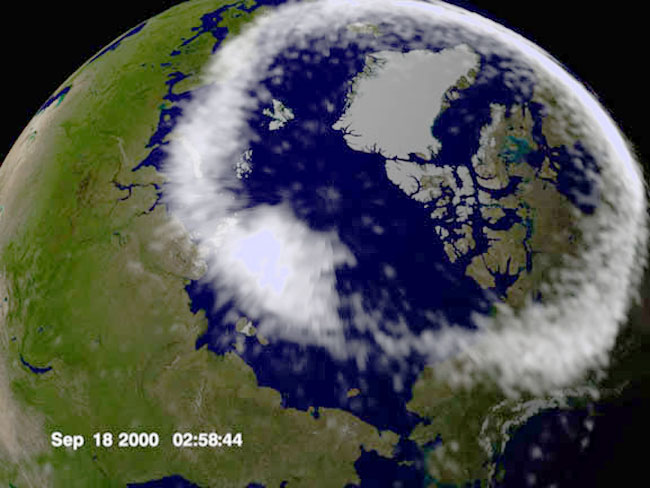Credit & Copyright: IMAGE Satellite,
NASA
Explanation:
What are auroras made out of?
Most auroras are caused by the
solar wind exciting
electrons that are funneled down the
Earth's magnetic field.
These electrons strike
air molecules, liberating other electrons that
glow when re-acquired.
Sometimes, however,
auroras composed mostly of heavier
protons impact the Earth,
causing a more energetic display with strong
ultraviolet emission.
A proton aurora captured by the
IMAGE satellite in ultraviolet is
shown above ringing the
north magnetic pole of planet Earth.
Most electrons and protons
never reach the Earth to cause
auroras because they are completely deflected away at a
great distance by the
Earth's magnetic field.
The bright spot in the
auroral ring
indicates a particularly deep crack in the Earth's magnetic field where
protons were able to flow along a temporarily connected
region between the
Sun and the Earth,
relatively undeflected, until they impacted the
Earth's ionosphere.
1999 2000 2001 2002 2003 2004 2005 2006 2007 2008 2009 2010 2011 2012 2013 2014 2015 2016 2017 2018 2019 2020 2021 2022 2023 2024 2025 |
Январь Февраль Март Апрель Май Июнь Июль Август Сентябрь Октябрь Ноябрь Декабрь |
NASA Web Site Statements, Warnings, and Disclaimers
NASA Official: Jay Norris. Specific rights apply.
A service of: LHEA at NASA / GSFC
& Michigan Tech. U.
|
Публикации с ключевыми словами:
aurora - proton - полярное сияние - протон
Публикации со словами: aurora - proton - полярное сияние - протон | |
См. также:
Все публикации на ту же тему >> | |
